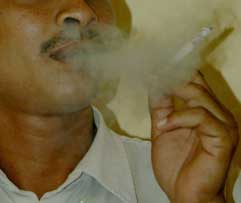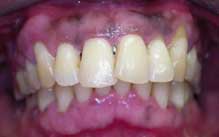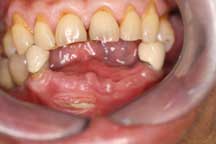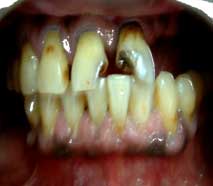
Smoking has been associated with many diseases including cancer, lung disease, heart disease and other health problems. Gum tissue is also affected by this smoking habit. Smokers are 4 times more likely to develop gum disease than non-smokers.
Malaysians smoke 23.7 billion cigarettes a year in 2012 compare to 18 billion cigarettes a year in 1998. Diseases related to smoking is the number one killer in this country with around 10,000 death. (http://www.ikim.gov.my/index.php/ms/berita-harian/6809-setiap-hari-50 -remaja-mulakan-tabiat-merokok).
What Is Gum Disease?
Gum (Periodontal) disease is an infection of the gums and the supporting structures of the teeth. It is one of the major causes of tooth loss among the adult population. Although bacteria in the mouth are the main cause of the disease, there are other risk factors which modify the initiation and progress of the infection. Smoking is one of the risk factors which can make gum disease worse.
How Does Smoking Affect Gum Disease?
Recent studies into smoking and gum disease have shown that smoking puts a person at an increased risk of gum disease. People who smoke are four times more likely than people who have never smoked to have a severe form of gum disease known as periodontitis. The more you smoke, the worse is the gum disease. Those who continue to smoke during gum treatment, will suffer 50% further bone loss during healing compare to those who did not smoke. Cigars, pipe smoking and smokeless tobacco have the same risk as cigarette smokers to this gum disease.
Compared with a non-smoker, a smoker is more likely to have the following problems:
- Calculus build-up on teeth. Calculus is the hardened soft deposit on your teeth and can only be removed during a professional cleaning.
- Deep pockets between teeth and gums.
- Loss of the bone and tissue that support teeth.
- Gum recession; receding of gum line exposes the roots of the teeth. This could increase the risk of tooth decay and cause hot/cold sensitivity.
- Poorer response to gum treatment and make the treatment results less predictable.
 |
Severe gum disease in a 35 year-old smoker : Swollen, puffy and receeding gums |
 |
Severe gum disease in 45 year-old smoker : Receeding gums and tooth loss |
 |
The gum condition of a smoker : Calculus, Staining of teeth, swollen gums, recession of gum. |
Why Does Smoking Affect Gum Health?
Tobacco smoke and nicotine cause small blood vessels to become narrow, this reduces the delivery of oxygen and nutrients to gum tissue .Cigarette smoking can also reduce the effectiveness of the body’s ability to fight infections. Some studies have even suggested that smokers are more likely to be infected with more aggressive gum disease-causing bacteria.
What Can I Do To Improve My Gum Health?
- Practice effective oral hygiene care :
- Tooth brushing twice daily.
- Flossing to clean the deposits between the teeth.
- Do not smoke or quit smoking if you are a smoker.
- Have regular dental check-ups and seek treatment for gum problems as early as possible once you observe any of the symptoms of the disease.
Does Quit Smoking Improve Gum Condition?
Studies have shown that former smokers and those who had never smoked respond better to the treatment of gum disease than those who still smoke. Patients who stopped smoking will have a better chance of being successful with the gum treatment.
Quitting smoking right now can provide long-term health benefits. If you would like to quit but don’t know how to, talk to your doctor about it and you can also seek advice from quit smoking support groups such as Malaysia Council For Tobacco Control (MCTC).
References
-
Bergstrom J, Eliasson S & Dock J. A 10-year prospective study of tobacco smoking and periodontal health. J Periodontol. 2000; 71: 1338-1347
-
Bergstrom J, Eliasson S & Dock J. Exposure to smoking and periodontal health. J Clin Periodontol. 2000; 27: 61-68
-
Preber H, Bergstrom J. Effect of cigarette smoking on periodontal healing following surgical therapy. J Clin Periodontol. 1990; 17: 324-328
-
Johnson GK, Guthmiller JM. The impact of cigarette smoking on periodontal disease and treatment. Periodontol 2000. 2007; 44: 178-194.
-
Salvi, GE, et al. Influence of risk factors on the pathogenisis of periodontitis. Periodontol 2000, 1997;14:173-201.
-
Gelskey, SC. Cigarette smoking and periodontitis: Methodology to assess the strength of evidence in support of a causal association. Community Dent. Oral Epidemiol. 1999;27:16-24.
-
Baab,DA and Oberg, PA. The effect of cagarette smoking on gingival blood flow in humans. J. Clin Periodontol. 1987;14:418-424.
-
Barbour,SE, et al. Tobacco and smoking: Environmental factors that modify the host response (immune system) and have an impact on periodontal health. Crit Rev Oral Biol Med 1997;8:437-460.
-
Zambon,JJ, et al. Cigarette smoking increases the risk for subgingival infection with periodontal pathogens. J. Periodontol. 1996;67(suppl.):1050-1054
-
Rivera-Hidalgo F. Smoking and periodontal disease. Periodontol 2000. 2003; 32: 50-58.
| Last Reviewed | : | 23 June 2014 |
| Writer | : | Dr. Rajeswary a/p Raman |
| Accreditor | : | Dr. Norhani bt. Abd Rani |
| Reviewer | : | Dr. Ahmad Sharifuddin b. Mohd Asari |







